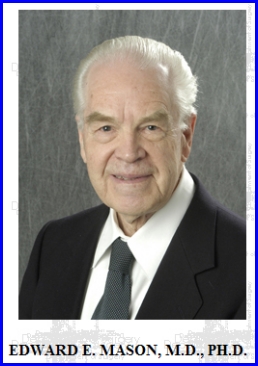|
UI Health Care News: Week of April 14, 2003
UI pioneer of obesity surgery publishes overview
 A
University of Iowa physician who is considered the "father of obesity
surgery" has published an overview article on the development and future
of surgical weight loss procedures. The article by Edward E. Mason, M.D.,
Ph.D., UI professor emeritus of surgery, in the April issue of The
Archives of Surgery, provides a historical perspective on weight loss
surgery techniques and outlines some innovations in surgical weight loss
operations that could improve safety and success. A
University of Iowa physician who is considered the "father of obesity
surgery" has published an overview article on the development and future
of surgical weight loss procedures. The article by Edward E. Mason, M.D.,
Ph.D., UI professor emeritus of surgery, in the April issue of The
Archives of Surgery, provides a historical perspective on weight loss
surgery techniques and outlines some innovations in surgical weight loss
operations that could improve safety and success.
This issue of The Archives of Surgery is devoted to a review of current
trends in the surgical treatment of morbid obesity and accompanies the
April 9 issue of The Journal of the American Medical Association (JAMA),
which focuses on obesity research.
Mason began performing gastric bypass surgery for weight reduction in
1966. One of the procedures most commonly used today to surgically treat
obesity is a type of bypass procedure called Roux-en-Y gastric bypass
where the stomach is reduced to a small pouch, which holds about one ounce
of food, and the first two feet of the small intestine are bypassed.
Although bypass procedures like Roux-en-Y result in substantial weight
loss, they also significantly affect the normal digestion process,
producing adverse side effects. Bypassing the first part of the intestine
interferes with normal absorption of critical nutrients and causes
complications related to vitamin and mineral deficiencies such as anemia
(iron deficiency) and metabolic bone disease (calcium and vitamin D
deficiency).
These side effects led Mason to develop a simpler procedure known as
vertical banded gastroplasty, which he began performing in 1980. Vertical
banded gastroplasty reduces the region of the stomach that can initially
receive food, but does not alter the rest of the digestive process.
" The future of weight loss surgery rests in greater use of simple stomach
restriction procedures like vertical banded gastroplasty, which preserve
the normal weight-maintenance mechanisms of the body," Mason said. "If
simple restriction procedures did not produce sufficient weight loss, it
was always my inclination to work with the patient to solve other problems
affecting weight loss rather than going to a more radical procedure."
It is estimated that almost two thirds of American adults are overweight
or obese. In addition, the incidence of obesity in children has doubled in
the last 20 years with about 15 percent of children between ages 6 and 19
years old now affected. Obesity has been predicted to surpass smoking as
the leading cause of preventable deaths in the United States. Over 100
billion dollars are spent annually on treatment of health complications
resulting from obesity.
Mason said that since the mid 1990s scientists have learned a great deal
about the biochemical mechanisms that influence food intake and weight.
" I would like to see greater use of simple restriction procedures that do
not rearrange these finely balanced mechanisms," Mason added.
In addition to pioneering new techniques for weight reduction surgery,
Mason also established the American Society of Bariatric Surgery and the
International Bariatric Surgery Registry. The registry, which Mason
continues to direct, maintains a database of over 30,000 patients who have
undergone surgery for weight loss.
Mason is retired from the UI faculty, but he continues to be active in
teaching and publishing.
This article appeared at the following link but since, has
been removed:
uihealthcare.com /news /news /2003/04/14 obesitysurg.html
It is assumed that one can request the article by
contacting the U of I at:
http://www.uihealthcare.com/news/news/archive.html As you
notice they have only got back to year 2005 archived on the web but if you
request, they likely have the other archives. |
 A
University of Iowa physician who is considered the "father of obesity
surgery" has published an overview article on the development and future
of surgical weight loss procedures. The article by Edward E. Mason, M.D.,
Ph.D., UI professor emeritus of surgery, in the April issue of The
Archives of Surgery, provides a historical perspective on weight loss
surgery techniques and outlines some innovations in surgical weight loss
operations that could improve safety and success.
A
University of Iowa physician who is considered the "father of obesity
surgery" has published an overview article on the development and future
of surgical weight loss procedures. The article by Edward E. Mason, M.D.,
Ph.D., UI professor emeritus of surgery, in the April issue of The
Archives of Surgery, provides a historical perspective on weight loss
surgery techniques and outlines some innovations in surgical weight loss
operations that could improve safety and success.